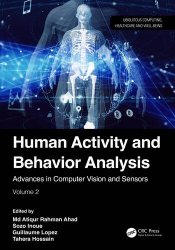Human Activity and Behavior Analysis: Advances in Computer Vision and Sensors: Volume 2
- Добавил: literator
- Дата: 9-03-2024, 04:45
- Комментариев: 0
 Название: Human Activity and Behavior Analysis: Advances in Computer Vision and Sensors: Volume 2
Название: Human Activity and Behavior Analysis: Advances in Computer Vision and Sensors: Volume 2Автор: Atiqur Rahman Ahad, Sozo Inoue, Guillaume Lopez
Издательство: CRC Press
Год: 2024
Страниц: 285
Язык: английский
Формат: pdf (true)
Размер: 18.6 MB
Human Activity and Behavior Analysis relates to the field of vision and sensor-based human action or activity and behavior analysis and recognition. The book includes a series of methodologies, surveys, relevant datasets, challenging applications, ideas, and future prospects.
The book discusses topics such as action recognition, action understanding, gait analysis, gesture recognition, behavior analysis, emotion and affective computing, and related areas. This volume focuses on two main subject areas: Movement and Sensors, and Sports Activity Analysis.
Activity recognition has been a hot research topic for some years now. One of its main applications is ambient assisted living, so that people in need of assistance might stay in their own environment longer than previously possible. There is a wide range of sensors of different types and applications being tested in this domain, ranging from ambient binary motion sensors and pressure mats to wearable gyroscopes or sensors monitoring body functions. This is also due to the many different levels of surveillance tested by the researchers. Where ambient sensors can usually only detect whether a certain device is in use or area is occupied not distinguishing residents, wearables can precisely monitor the current status of a particular person. Consequently, there is also a large variety of methods employed for activity recognition, such as conditional random fields (CRF), support vector machines (SVM) or hidden Markov models (HMM). Furthermore, the applications differ in the type of features used and the offline or online activity recognition. Virtual stochastic sensors (VSS) have been developed for behavior reconstruction of partially observable stochastic systems and to enable solving backward problems in the realm of stochastic modeling and simulation. VSS provide different types of models for discrete and hybrid doubly stochastic systems and the respective analysis methods to perform behavior reconstruction. The models are based on the ideas of HMM, but extend these by arbitrary non-Markovian distribution functions for multiple concurrent processes. The reconstruction methods used stem from state space-based simulation using supplementary variables to extend the discrete state definition. Discretizing the time domain results in a simple algorithmic analysis method, instead of solving partial differential equations. This enables VSS to perform system behavior reconstruction for a wide variety of real-world problems.
The library we selected to use here is Apache Beam and in-memory database Redis. There are two reasons to use Apache Beam: The first is the ease of implementation. Apache Beam can be written in programming languages such as Java or Python, and the process is represented as a pipeline, so it is intuitive and easy to implement. The second is that it can be used with various stream processing engines. Apache Beam can output the code in various formats, which runs on a stream processing engine such as Apache Flink or Google Dataflow. Therefore, it is easy to choose execution platform: Apache Flink is good for running the system locally, while Google Dataflow is a cloud engine for operational use in the field.
We used Machine Learning methods for classification and extracted statistical features from raw 3-D acceleration and 3-D angular velocity for each axis within the segment. In this work, we compared three types of classifiers, multi-class support vector machine (SVM), Random Forest (RF), and K Nearest Neighbors (KNN) from Scikit-learn, a Machine Learning library for Python. We chose to set all of the parameters of Machine Learning models to default values of Scikit-learn. Before training data with classifiers, we chose RF and KNN classifiers which calculate distances between different points in their algorithm.
Скачать Human Activity and Behavior Analysis: Advances in Computer Vision and Sensors: Volume 2
Внимание
Уважаемый посетитель, Вы зашли на сайт как незарегистрированный пользователь.
Мы рекомендуем Вам зарегистрироваться либо войти на сайт под своим именем.
Уважаемый посетитель, Вы зашли на сайт как незарегистрированный пользователь.
Мы рекомендуем Вам зарегистрироваться либо войти на сайт под своим именем.
Информация
Посетители, находящиеся в группе Гости, не могут оставлять комментарии к данной публикации.
Посетители, находящиеся в группе Гости, не могут оставлять комментарии к данной публикации.
